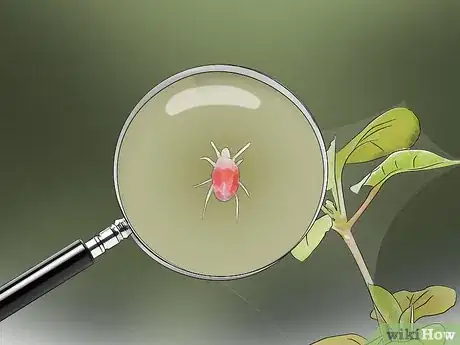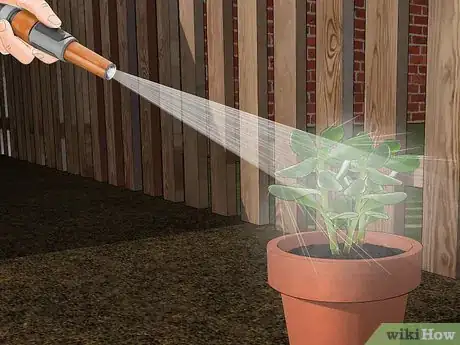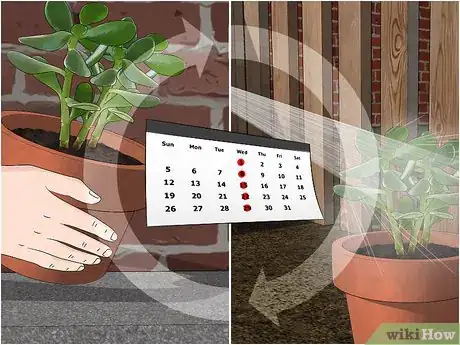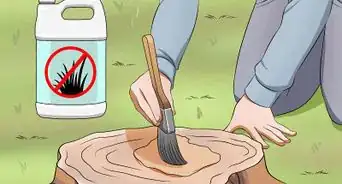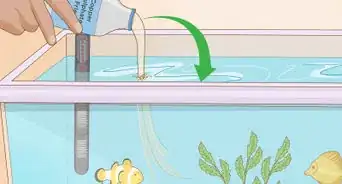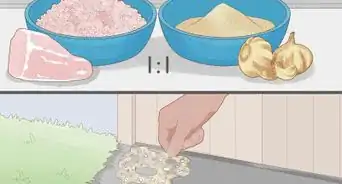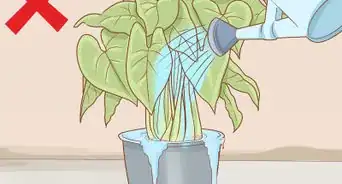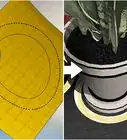This article was co-authored by Lauren Kurtz. Lauren Kurtz is a Naturalist and Horticultural Specialist. Lauren has worked for Aurora, Colorado managing the Water-Wise Garden at Aurora Municipal Center for the Water Conservation Department. She earned a BA in Environmental and Sustainability Studies from Western Michigan University in 2014.
There are 10 references cited in this article, which can be found at the bottom of the page.
This article has been viewed 76,774 times.
Spider mites are tiny insects that are difficult to see with the naked eye and can wreak havoc on the plants in your garden or lawn. If you suspect that you have mites, you should confirm that you have them before attempting to remove them. Once you know that they are on your plants, you can eliminate the bugs with plain water from a garden hose, or you can use a horticultural oil to remove and prevent more serious infestations.
Steps
Spotting Signs of Spider Mites
-
1Look for yellow or brown dots on your plant's leaves. Spider mites will weaken your plant, and the leaves will often form small yellow or brown dots. You may also notice leaves drying up and falling off your plant.[1]
-
2Examine your plants for webbing. Spider mites will leave webs under the leaves and stems on the plant. Look at your plants daily to see if there is webbing on any of your plants.[2]Advertisement
-
3Search for mites with a magnifying glass. Since spider mites are less than 1 mm in size, they can be hard to see with the naked eye. Purchase a magnifying glass from a department store or online and examine the leaves on your plants. If you see small specks moving on the leaves, there's a good chance you have spider mites.[3]
-
4Shake your plant's leaves over a white piece of paper. If you don't have a magnifying glass, you can use a white sheet of paper to see the mites. Hold a piece of paper under the leaves of your plant and then shake them. If you see green, brown, or black specks start to move over the surface of the paper, you have spider mites.[4]
- You can also crush the bugs with your finger. If they streak green, they are plant-feeding mites. If they are orange or yellow, they are probably beneficial predators.
Removing Mites with Water
-
1Isolate the affected plants. If you notice that you have spider mites and want to minimize their damage to your plants, it's best to separate the mite-infested plants. Move them to a different part of your garden or indoors before you try to remove them.[5]
-
2Spray down your plants with a hose. Water from a hose is strong enough to kill spider mites. Point a hose towards your plants and spray the leaves down with cold water. Remember to spray under the leaves as well so that you kill all of the mites.
-
3Repeat the process once a week. Keep the mite infested plants isolated for at least a month so that the spider mites don't spread to your other plants. Water from a hose is not strong enough to destroy spider mite eggs, so spraying the plants down once a week for a month will ensure that you kill the new mites that are hatching.
Using Horticultural Oil
-
1Dilute horticultural oil with warm water in a spray bottle. Horticultural oils are oil-based products that smother insects and their eggs. You can purchase horticultural oil at a home and gardening store or online.[6] Before diluting the horticultural oil, make sure to read the instructions that came with it so that you know how much water you should use and whether it's safe to use on your plants.[7]
- Use traditional horticultural oil in the summer.
- Use dormant horticultural oil in the fall and spring.[8]
-
2Move the plants with the mites inside a garage or shed. Horticultural oil may be affected by rain or high humidity and moving them inside will help prevent this. Avoid using horticultural oil on maple trees, hickory trees, cryptomeria, and spruce trees and read the instructions to make sure that they are safe to use on your plants.[9]
-
3Thoroughly spray the plants with the oil. Since water and oil separate, it's important that you shake the bottle regularly as you use it. Saturate the top and bottom of the leaves with the oil. Allow the oil to soak in and kill the mites and their eggs.[10]
- Horticultural oil works by suffocating the mites, so it's important you get complete coverage.
- Do not use the oils on flowers because it could damage them.
-
4Spray every 2-3 weeks until the mites are dead. Check for spider mites periodically throughout the rest of the week. If you notice that mites are still hatching, spray the plant down again.[11]
Preventing Spider Mite Infestations
-
1Prune affected portions of your plants. If you notice webbing on branches or spots on your leaves, you should prune these parts of the plant with hand pruners or shears. Discard the infested parts of the plant in the trash.[12]
- Throwing away mite infested portions of a plant near your garden may spread mites to other plants.
-
2Mist your plants with cold water. Moisture will keep mites away from your plants. Moving the plants indoors and misting them with water 2-3 times a day will reduce the likelihood of mites infesting the plants. You can also keep the plants over a saucer of water to prevent your plants from attracting mites.[13]
-
3Place a humidifier near your plants. Spider mites thrive in dry conditions, and a humidifier will help keep them away. Do not use a humidifier when applying horticultural oils.[14]
Community Q&A
Did you know you can get expert answers for this article?
Unlock expert answers by supporting wikiHow
-
QuestionDo spider mites bite you?
 Lauren KurtzLauren Kurtz is a Naturalist and Horticultural Specialist. Lauren has worked for Aurora, Colorado managing the Water-Wise Garden at Aurora Municipal Center for the Water Conservation Department. She earned a BA in Environmental and Sustainability Studies from Western Michigan University in 2014.
Lauren KurtzLauren Kurtz is a Naturalist and Horticultural Specialist. Lauren has worked for Aurora, Colorado managing the Water-Wise Garden at Aurora Municipal Center for the Water Conservation Department. She earned a BA in Environmental and Sustainability Studies from Western Michigan University in 2014.
Professional Gardener
-
QuestionHow do I get rid of spider mites on my plants?
 Lauren KurtzLauren Kurtz is a Naturalist and Horticultural Specialist. Lauren has worked for Aurora, Colorado managing the Water-Wise Garden at Aurora Municipal Center for the Water Conservation Department. She earned a BA in Environmental and Sustainability Studies from Western Michigan University in 2014.
Lauren KurtzLauren Kurtz is a Naturalist and Horticultural Specialist. Lauren has worked for Aurora, Colorado managing the Water-Wise Garden at Aurora Municipal Center for the Water Conservation Department. She earned a BA in Environmental and Sustainability Studies from Western Michigan University in 2014.
Professional Gardener
Things You'll Need
- Garden hose
- Water
- Horticultural Oil
- Spray bottle
- Magnifying glass
- Paper
- Shears or handheld pruners
- Humidifier (optional)
References
- ↑ http://www.getridofthings.com/pests/bugs/get-rid-of-spider-mites/
- ↑ https://www.planetnatural.com/pest-problem-solver/houseplant-pests/spider-mite-control/
- ↑ http://www.naturallivingideas.com/how-to-get-rid-of-red-spider-mites/
- ↑ http://www.ortho.com/smg/goART3/Howto/spider-mites-kill-spider-mites-garden-pests-ortho/32200014
- ↑ http://www.getridofthings.com/pests/bugs/get-rid-of-spider-mites/
- ↑ https://www.rodalesorganiclife.com/horticultural-oils-explained
- ↑ http://www.ladybug.uconn.edu/FactSheets/hort-oil.php
- ↑ http://ohioline.osu.edu/factsheet/HYG-2012-11
- ↑ https://entomology.ca.uky.edu/ef438
About This Article
To kill spider mites with water, start by isolating your infected plants. Then, spray the plants down with a strong hose, making sure to spray under all the leaves with cold water. Keep repeating this process once a week for at least month before putting your plants back. Alternatively, if you want to smother the mites to death, pour water and horticultural oil into a spray bottle. Spray your isolated plants completely every 2-3 weeks until all the mites are dead. For tips on how to prevent spider mite infestations, keep reading!


